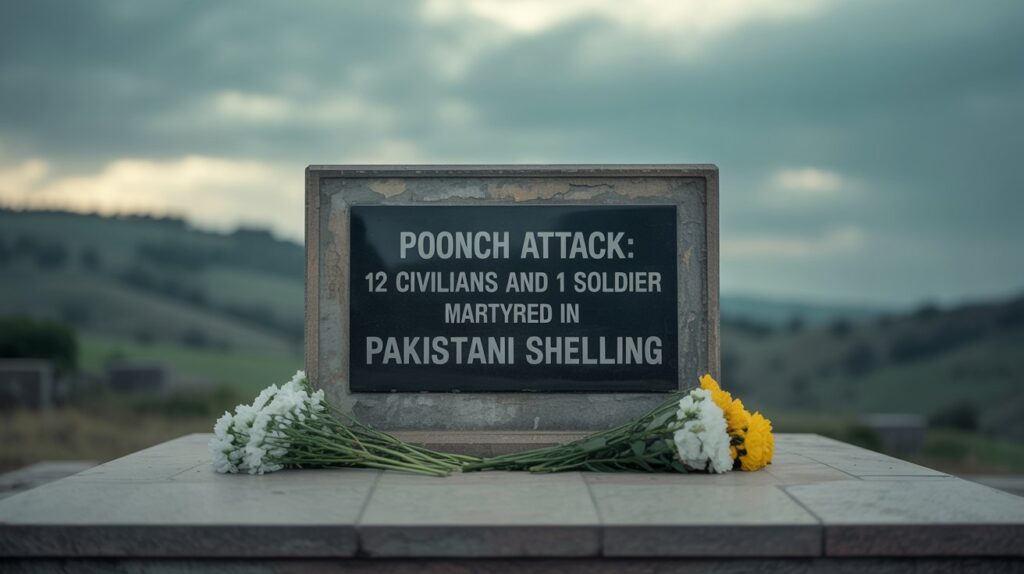The night of May 7, 2025, turned into a nightmare for the aam aadmi of Poonch, Jammu and Kashmir, as Pakistani forces unleashed a barrage of shells across the Line of Control (LoC). The dastardly Poonch attack claimed the lives of 12 civilians, including four children, and one brave jawan, Lance Naik Dinesh Kumar, while injuring 42 others. This tragic event followed India’s bold Operation Sindoor, a series of precision strikes on terrorist hideouts in Pakistan and Pakistan-occupied Kashmir (PoK), raising tensions between the two nations .
Background: The Spark of Operation Sindoor
The Pahalgam Terror Attack
The roots of the Poonch attack trace back to April 22, 2025, when terrorists struck Pahalgam, a serene tourist spot in Jammu and Kashmir. The attack was brutal, killing 26 civilians—25 Indians and one Nepali citizen. Evidence pointed to Pakistan-based terror groups like Lashkar-e-Taiba, known for past atrocities like the 2008 Mumbai attacks. The nation mourned, and the government vowed to act decisively (NDTV).
India’s Response: Operation Sindoor
On May 7, 2025, India launched Operation Sindoor, a high-tech military operation named by PM Narendra Modi to symbolize justice for the victims. The Indian Army, Navy, and Air Force conducted 24 precision missile strikes on nine terror camps in Pakistan and PoK, including Markaz Taiba in Muridke, infamous for training Mumbai attack terrorists, and Jaish-e-Mohammed’s headquarters in Bahawalpur. Using SCALP cruise missiles and loitering munitions, the operation eliminated over 70 terrorists and crippled terror networks, showcasing India’s military prowess (NDTV).
The Poonch Attack: A Night of Terror
Eyewitness Accounts
The Pakistani retaliation came swiftly, with shelling starting around 2 AM on May 7, targeting Poonch’s civilian areas and military posts. The scene was chaotic, as described by locals. Mohd Zahid, a Poonch resident, shared, “It was like a war zone with the injured screaming for help and families forced to look for cover. The damage was everywhere.” Khurshid Ahmad from Dhaki added, “We weren’t expecting this at night. We’re lucky to be alive and have moved to a safer place” (LiveMint). Sardar Navneet Singh from Mankote expressed anger: “Pakistan targeted civilians after missing military targets. Our homes are in ruins.”
Casualties and Destruction
The Poonch attack was devastating. According to reports, 12 civilians, including three children aged 12–14 from Kalaani and Dungus, and one soldier, Lance Naik Dinesh Kumar of the 5 Field Regiment, were martyred. Another 42 people were injured, many critically (The Hindu). The shelling, using heavy artillery and mortars, hit villages like Mankote, Mendhar, Thandi Kassi, and Poonch city, leaving a trail of destruction—damaged homes, burnt vehicles, and debris-littered streets. Over 150 residents of Dhaki were displaced after more than a dozen houses were hit.
| Detail | Information |
|---|---|
| Date | May 7, 2025 |
| Civilian Deaths | 12, including 4 children |
| Military Deaths | 1 (Lance Naik Dinesh Kumar) |
| Injuries | 42, several critical |
| Areas Affected | Mankote, Mendhar, Thandi Kassi, Poonch city |
| Damage | Homes, shops, vehicles; over 150 displaced from Dhaki |
Community and Official Reactions
Akal Takht Jathedar’s Condemnation
The attack struck a deep chord in the Sikh community, as shells damaged the Central Gurdwara Sri Guru Singh Sabha in Poonch, killing three Sikhs: Bhai Amrik Singh, Bhai Amarjeet Singh, and Bhai Ranjit Singh, along with Bibi Ruby Kaur in Manakot. Giani Kuldeep Singh Gargaj, the Acting Jathedar of Sri Akal Takht Sahib, condemned the violence, stating, “The attack on Gurdwara Sri Guru Singh Sabha and the loss of Sikh lives is a blow to humanity.” He urged India and Pakistan to choose diplomacy, adding, “War devours the innocent. Peace is not weakness—it’s strength” (Indian Express).
Indian Army’s Tribute
The Indian Army’s White Knight Corps honored Lance Naik Dinesh Kumar’s sacrifice, stating, “We salute the supreme sacrifice of L/Nk Dinesh Kumar and stand in solidarity with all victims of the targeted attacks on innocent civilians in Poonch” (NDTV). The Army retaliated, causing significant damage to Pakistani posts.
Political and Community Response
Shiromani Akali Dal chief Sukhbir Singh Badal called the gurdwara attack a “direct assault on a place of worship,” demanding a strong government response. The Indian government convened an all-party meeting on May 7 to discuss the escalating situation, signaling a unified approach to address the crisis. Locally, NGOs and the administration have set up relief camps, providing food, shelter, and medical aid to displaced families.
The Bigger Picture: Poonch’s Plight
Poonch has long been a flashpoint in India-Pakistan relations, with civilians often caught in the crossfire of ceasefire violations. The May 7 attack is a grim reminder of the challenges faced by border residents, who live under the constant threat of violence. Social media videos of the destruction sparked outrage, with many calling for an end to such senseless acts. The attack also targeted a UN field station in Poonch, raising concerns about violations of international norms.
Moving Forward
The Poonch attack highlights the fragile peace along the LoC and the human cost of geopolitical tensions. While Operation Sindoor dealt a blow to terrorism, the retaliation has left Poonch’s residents grieving. As India strengthens its defenses and engages in diplomatic efforts—evidenced by NSA Ajit Doval’s talks with international counterparts—the focus remains on protecting civilians (LiveMint). The nation stands united, with our thoughts with the families of the martyrs and the injured, hoping for a future where peace prevails over conflict.


